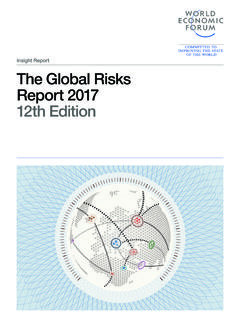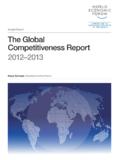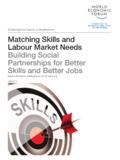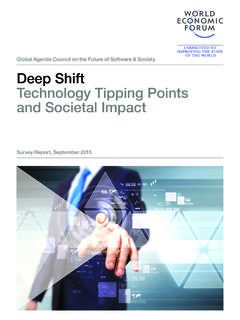Transcription of Aluminium for Climate: Exploring pathways to decarbonize ...
1 In collaboration with Accenture Aluminium for climate : Exploring pathways to decarbonize the Aluminium industry COMMUNITY REPORT. NOVEMBER 2020. Cover: Unsplash/Jannik Selz;. Inside: Getty Images/JarekJoepera; Unsplash/Emilie Lusant;. Unsplash/Dylan Gillis; Unsplash/Geran de Klerk Contents 3 Executive summary 4 1 Introduction 5 2 The case for change 12 3 pathways to decarbonization 19 4 The need for collaborative action 25 5 Conclusion 27 Appendix: Acknowledgements 28 Contributors 29 Endnotes 2020 World Economic Forum. All rights reserved. No part of this publication may be reproduced or transmitted in any form or by any means, including photocopying and recording, or by any information storage and retrieval system. Aluminium for climate : Exploring pathways to decarbonize the Aluminium industry 2.
2 November 2020 Aluminium for climate : Exploring pathways to decarbonize the Aluminium industry Executive summary The Aluminium sector is an integral part of the sustainable economy, but as a carbon-intensive industry it will need to proactively address its sectoral carbon footprint. The Aluminium industry generates more than Successful decarbonization of the Aluminium billion tonnes of CO2e (carbon dioxide equivalent) industry relies on joint action across the value chain emissions annually around 2% of global from suppliers, Aluminium players and customers. anthropogenic emissions. In view of the projected Collaborative research and development will reduce growth in demand for Aluminium , emissions need the cost to individual companies that operate on to be addressed to limit global warming to C in slim profit margins and result in industry-wide order to curb climate change risks.
3 In this report, the benefits. Aluminium players, especially smelting World Economic Forum and Accenture explore the operations, should work closely with power case for change in the Aluminium industry and aim providers to support the transition to renewables to inspire the sector, its suppliers and customers to and cost-effectively scale low-carbon electricity. address this challenge proactively and collaboratively. All industry players can start taking action to begin Focus on three priority areas would significantly the path to decarbonization, such as: reduce the emissions of the Aluminium industry. First, the decarbonization of electricity consumption Working internally to understand current-state (accounting for more than 60% of the industry's emissions and set targets to decarbonize carbon footprint).
4 The Aluminium industry's power supply can be fundamentally addressed through Collaborating with value-chain partners on the transition to renewable energy sources and/ research and development opportunities, or carbon capture, utilization and storage (CCUS) including inert anode development, CCUS. technologies. Second, the decarbonization of applications and improved scrap collection and direct emissions from the processing of Aluminium sorting methods (accounting for 25 30% of sectoral emissions). The highest-impact pathways to decarbonize process Influencing global decarbonization policy to emissions are transitioning to technologies that drive common standards can provide heat and steam without the use of fossil fuels and the development of a non-carbon While the Aluminium industry faces many challenges anode.
5 Finally, the recycling of Aluminium scrap, in its path towards decarbonization, a net-zero future which requires just 5% of the energy needed to is achievable. We call upon leaders in the Aluminium produce primary Aluminium . Increased collection industry to engage in the conversation about and recovery of post-consumer scrap can reduce decarbonization, to set ambitious targets and to the need for carbon-intensive primary Aluminium by work together on a path to reach net zero by 2050. up to 15%. Aluminium for climate : Exploring pathways to decarbonize the Aluminium industry 3. 1 Introduction As a heavy emitter, the Aluminium industry has a pivotal role to play in meeting global decarbonization goals. The heavy industry sectors together emit more economy given its prominence in supporting global than 10 gigatonnes (Gt) of total greenhouse gas growth.
6 The Aluminium for climate Initiative was (GHG) emissions, of which the Aluminium industry established in 2019 under the Mission Possible generates around billion tonnes of CO2e Platform, a World Economic Forum coalition annually, predicted to increase by 50% by 2050 committed to reducing heavy industry GHG. under a business-as-usual , 2 emissions. The aim of the initiative is to support the sector's collective efforts in addressing its The world relies on Aluminium . As the second major challenges and to help capture opportunities most-used metal in the world by mass, it is integral to meet society's decarbonization to several vital industries including construction, transport and power transmission. While Aluminium In this report, the World Economic Forum and is an essential material for a sustainable future, the Accenture explore the case for change in the industry is currently responsible for 2% of global Aluminium sector, including industry-specific anthropogenic GHG decarbonization challenges, examples both within and outside of the industry, and potential pathways The United Nations calls upon all to ensure 2020 for tangible impact to reduce the sector's carbon ushers in the decade of delivery.
7 For every industry, footprint. It aims not only to tell the story of why including Aluminium , now is the time to act. action is needed, but also to inspire the sector, its suppliers and customers to address this challenge The Aluminium industry must play a key role proactively and collaboratively. in accelerating the transition to a low-carbon Aluminium for climate : Exploring pathways to decarbonize the Aluminium industry 4. 2 The case for change Despite challenges, now is the time to act to sustainably meet increasing Aluminium demand. Aluminium for climate : Exploring pathways to decarbonize the Aluminium industry 5. Global response to climate change Scientists around the world agree that human In 2018, the Intergovernmental Panel on climate activity has led to a sharp increase in greenhouse Change (IPCC) published a special report detailing gas (GHG) concentrations, which is causing rapid what it would take to limit global warming to C.
8 climate change that threatens livelihoods around the above pre-industrial Human activities have world affecting food security, weather patterns, already caused a 1 C rise in global warming and sea levels and In response, nearly every at the current rate of emissions it is likely that we nation signed the Paris climate Agreement in 2015. will reach C warming between 2030 and 2052, The Paris Agreement aims to strengthen the global accelerating climate -related events. response to the threat of climate change by keeping a global temperature rise this century well below The IPCC states that to limit global warming to 2 C above pre-industrial levels and to pursue C, it is necessary to reduce greenhouse gas efforts to limit the temperature increase even emissions by 45% from 2010 levels by 2030 and further to C.
9 6 to reach net zero by Even under the 2 C. scenario, rapid action is needed; the International Since that initial commitment in 2015, countries Aluminium Institute (IAI) projects that the Aluminium and organizations around the world have developed sector would need to eliminate emissions from even more ambitious decarbonization targets to electricity consumption (currently making up more combat climate change as additional information on than 50% of sector emissions) and reduce direct projected pathways becomes available. emissions by 50% by 2050 (on a 2018 baseline).9. Taking action now At this point, there is no evidence that greenhouse fight against climate change. Although the 26th gas emissions have peaked and begun to UN climate Change Conference (COP26) has With every year the peak is delayed, more rapid been postponed to the autumn of 2021 due to action will be required to meet either a C or 2 C the COVID-19 pandemic, it is often argued that scenario.
10 As consumers, investors and governments COVID-19 has already given us a glimpse . expect action, companies face increasing pressure of what a full-fledged climate crisis and ecosystem to limit the impact on the environment or risk facing collapse could entail .11 COP26 will pay particular the court of public opinion and legal repercussions. attention to the role of industrial decarbonization pathways and the progress of heavy industry Fortunately, 2020 seems to mark an inflection sectors to reach their commitments. point of both interest and urgency in the global Materials such as Aluminium are critical to achieving a sustainable economy. Substantial progress has been made, but more is needed. As climate Action Champions we support this journey towards a net-zero industry by working with our allies in all continents and by supporting the establishment of closer interlinkage points with key customer industries and policy-makers.









